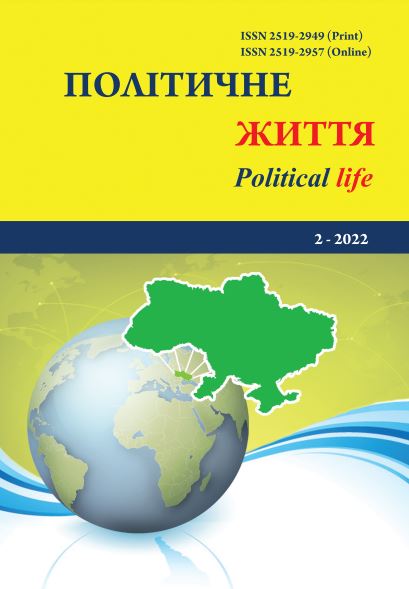Ukrainian Digital Political Discourse Emotionality Analysis During the Full-Scale Russian Invasion (On the Basis of the Most Popular Telegram Channels)
DOI:
https://doi.org/10.31558/2519-2949.2022.2.7Keywords:
emotionality, Telegram, political discourse, war, Ukraine, RussiaAbstract
The analysis of emotional reactions of the most popular Telegram channels from the category (News and Media) is conducted in the paper. Period: two months since the full-scale Russian invasion were taken into account. The paper’s aim is to define and to interpret the Ukrainian Telegram-channels’ leading emotions and to observe the most popular reactions’ dynamics. A computer program (Python language) was designed for this objective. The program collected all the text items from the Telegram-channels, looked for the emoji and calculated its’ number. It was defined, that for the observation period mostly positive emotions prevailed: pride, delight, gratitude. Telegram-channels, which aren’t owned by the traditional mass media additionally used humor, sarcastic laughter at the enemy, irony. The emotionality dynamics analysis of ‘Ukraina Sejchas’ Telegram channel shown, that at the beginning the first phase of the war the reactions usage was more restrained. Afterwards, at the end of the first phase the number increased and decreased before the battle for Donbas. The periodization of the emotional reactions was created. Two weeks after the full-scaled Russian invasion gratitude and delight towards the defenders were the most popular. Afterwards the period of laughter, irony, sarcasm over the enemy was observed. In April, in anticipation of the battle for Donbas again gratitude and delight prevailed. And since 15th of April proud and strength dominated.
The reactions usage analysis of the most popular Ukrainian Telegram-channels shown, that in Ukrainian digital political discourse the positive reactions prevailed mostly. Negative reactions were observed not so often. There were anger or irritation. Horror, fear, and sadness were mentioned rarely despite the style of Russian behavior on the battlefields, when attacks on civilians are held, terror and intimidation are used as instruments of the war. Thus, on the emotional level Ukrainian society resisted the invasion, demonstrated confidence and strength.
References
Blumler, J., Kavanagh, D. The Third Age of Political Communication: Influences and Features. Political Communication. 1999. Vol. 16. No. 3. P. 209–230. DOI:10.1080/105846099198596
Brader, T. Striking a Responsive Chord: How Political Ads Motivate and Persuade Voters by Appealing to Emotions. American Journal of Political Science. 2005. № 49. P. 388–405.
Goldhaber, M. (1997). The Attention Economy and the Net. First Mind. URL: https://firstmonday.org/ojs/index.php/fm/article/view/519/440/
Gonçalves, P., Benevenuto, F., Cha, M. PANAS-t: A Pychometric Scale for Measuring Sentiments on Twitter. ArXiv. 2013. URL: https://arxiv.org/pdf/1308.1857.pdf
Grimmer, J., Stewart, B. Text as Data: The Promise and Pitfalls of Automatic Content Analysis Methods for Political Texts. Political Analysis. 2013. № 21. P. 267–297.
Gustafsson, N. (2010). This Time It’s Personal: Social Networks, Viral Politics and Identity Management. In D. Riha, A. Rodopi – editors. Emerging Practices in Cyberculture and Social Networking. Leiden: Brill, 2010. P. 3-24.
Huddy, L., Mason, L., L., Aarøe, L. Expressive Partisanship: Campaign Involvement, Political Emotion, and Partisan Identity. American Political Science Review. 2015. № 109. P. 1-17.
Jasper, J. Emotions and Social Movements: Twenty Years of Theory and Research. Review of Sociology. 2011. № 37. P. 285-303.
Jost, J., Barberá, P., Bonneau, R., Langer, M., Metzger, M., Nagler, J., Tucker, J. How Social Media Facilitates Political Protest: Information, Motivation, and Social Networks. Political Psychology. 2018. № 39. P. 85-118.
Miller, P. The Emotional Citizen: Emotion as a Function of Political Sophistication. Political Psychology. 2011. № 32. P. 575-600. DOI:10.1111/J.1467-9221.2011.00824.X
Nussbaum, M. Political Emotions Why Love Matters for Justice. Cambridge: Belknap Press, 2015.
Ott, B. L. The age of Twitter: Donald J. Trump and the politics of debasement. Critical Studies in Media Communication. 2017. Vol. 34. No. 1. P. 59-68. DOI:10.1080/15295036.2016.1266686
Pagano, S., Huo, Y. The Role of Moral Emotions in Predicting Support for Political Actions in Post-War Iraq. Political Psychology. 2007. № 28. P. 227-255. DOI:10.1111/J.1467-9221.2007.00563.X
Parsons, B. Social Networks and the Affective Impact of Political Disagreement. Political Behavior. 2010. № 32. P. 181-204. DOI:10.1007/S11109-009-9100-6
Staiger, J., Cvetkovich, A., Reynolds, A. Political Emotions (New Agendas in Communication Series). Austin: Routledge, 2010.
Stieglitz, S., Dang-Xuan, L. Emotions and Information Diffusion in Social Media – Sentiment of Microblogs and Sharing Behavior. Journal of Management Information Systems. 2013. № 29. P. 217 – 248.
Valentino, N., Brader, T., Groenendyk, E., Gregorowicz, K., Hutchings, V. Election Night’s Alright for Fighting: The Role of Emotions in Political Participation. The Journal of Politics. 2011. № 73. P. 156-170.
Valentino, N., Hutchings, V., Banks, A., Davis, A. Is a Worried Citizen a Good Citizen? Emotions, Political Information Seeking, and Learning via the Internet. Political Psychology. 2008. № 29. P. 247-273.
Volkova, S., & Bachrach, Y. On Predicting Sociodemographic Traits and Emotions from Communications in Social Networks and Their Implications to Online Self-Disclosure. Cyberpsychology, behavior and social networking. 2015. 18(12). P. 726-736. DOI:10.1089/cyber.2014.0609
Wahl-Jorgensen, K. Emotions, Media and Politics. Cambridge: Polity Press, 2019.

